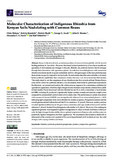| dc.contributor.author | Wekesa, Clabe | |
| dc.contributor.author | Kiprotic, Kelvin | |
| dc.contributor.author | Okoth, Patrick | |
| dc.contributor.author | Asudi, George O. | |
| dc.contributor.author | Muoma, John O. | |
| dc.contributor.author | Furch, Alexandra C. U. | |
| dc.contributor.author | Oelmüller, Ralf | |
| dc.date.accessioned | 2023-06-22T11:29:04Z | |
| dc.date.available | 2023-06-22T11:29:04Z | |
| dc.date.issued | 2023-05-30 | |
| dc.identifier.uri | https://doi.org/10.3390/ijms24119509 | |
| dc.identifier.uri | https://www.mdpi.com/1422-0067/24/11/9509 | |
| dc.identifier.uri | http://ir-library.mmust.ac.ke:8080/xmlui/handle/123456789/2228 | |
| dc.description.abstract | : Kenya is the seventh most prominent producer of common beans globally and the second
leading producer in East Africa. However, the annual national productivity is low due to insufficient
quantities of vital nutrients and nitrogen in the soils. Rhizobia are symbiotic bacteria that fix nitrogen
through their interaction with leguminous plants. Nevertheless, inoculating beans with commercial
rhizobia inoculants results in sparse nodulation and low nitrogen supply to the host plants because
these strains are poorly adapted to the local soils. Several studies describe native rhizobia with much
better symbiotic capabilities than commercial strains, but only a few have conducted field studies.
This study aimed to test the competence of new rhizobia strains that we isolated from Western Kenya
soils and for which the symbiotic efficiency was successfully determined in greenhouse experiments.
Furthermore, we present and analyze the whole-genome sequence for a promising candidate for
agricultural application, which has high nitrogen fixation features and promotes common bean yields
in field studies. Plants inoculated with the rhizobial isolate S3 or with a consortium of local isolates
(COMB), including S3, produced a significantly higher number of seeds and seed dry weight when
compared to uninoculated control plants at two study sites. The performance of plants inoculated
with commercial isolate CIAT899 was not significantly different from uninoculated plants (p > 0.05),
indicating tight competition from native rhizobia for nodule occupancy. Pangenome analysis and the
overall genome-related indices showed that S3 is a member of R. phaseoli. However, synteny analysis
revealed significant differences in the gene order, orientation, and copy numbers between S3 and the
reference R. phaseoli. Isolate S3 is phylogenomically similar to R. phaseoli. However, it has undergone
significant genome rearrangements (global mutagenesis) to adapt to harsh conditions in Kenyan
soils. Its high nitrogen fixation ability shows optimal adaptation to Kenyan soils, and the strain can
potentially replace nitrogenous fertilizer application. We recommend that extensive fieldwork in
other parts of the country over a period of five years be performed on S3 to check on how the yield
changes with varying whether conditions | en_US |
| dc.language.iso | en | en_US |
| dc.publisher | International Journal of Molecular Sciences | en_US |
| dc.subject | Molecular, Characterization, Indigenous, Rhizobia, Kenyan Soils, Nodulating ,Common Beans | en_US |
| dc.title | Molecular Characterization of Indigenous Rhizobia from Kenyan Soils Nodulating with Common Beans | en_US |
| dc.type | Article | en_US |

